Research on Building’s Carbon Emission Calculation and Reduction Strategy Based on Life Cycle Assessment (LCA) and Building in Formation Modeling (BIM): A Case Study in Beijing, China
Abstract
:1. Introduction
2. Methodology
2.1. Research Objects
2.2. Boundary Conditions
- Materials Production Stage: This stage includes the production processes of major structural materials (such as concrete and steel), envelope materials (such as mortar and waterproof membranes), and building components (such as stone and concrete blocks). Auxiliary materials are also considered. The estimation of material consumption was based on both on-site data collection and the utilization of BIM tools.
- Materials Transportation Stage: This stage covers the transportation of materials from their production sites to the construction site, including various transportation modes (such as heavy-duty diesel trucks and medium-duty diesel trucks) and their corresponding carbon emission factors. Transportation distances were estimated based on supplier quotations and typical delivery routes within the Beijing metropolitan area.
- Construction Stage: This stage not only includes the construction of the main structure but also the setup and dismantling of temporary facilities. It also encompasses the energy consumption of construction machinery (such as excavators, cranes, and mixers).
- Operation and Maintenance Stage: This stage encompasses the energy consumption of heating, air conditioning, lighting, and elevator systems, with particular emphasis on the actual energy consumption patterns of these systems during operation.
- Demolition and Recycling Stage: These stages encompass the operation of machinery during the demolition process and the transportation of waste along with the associated carbon emissions, and consider the recycling rates of recyclable materials (such as steel and glass) and the corresponding reduction in carbon emissions. The data in the above two stages were estimates based on BIM tools.
2.3. Calculation Standards
2.4. Calculation Methods
2.4.1. Building Materials Production Stage
2.4.2. Building Materials Transportation Stage
2.4.3. Building Construction Stage
2.4.4. Building Operation and Maintenance Stage
HVAC System
Lighting and Elevator System
Renewable Energy System
Urban Green Space Carbon Sink System
2.4.5. Building Demolition Stage
2.4.6. Building Recycling Stage
3. Results
3.1. Building Materials Production Stage
3.2. Building Materials Transportation Stage
3.3. Building Construction Stage
3.4. Building Operation Stage
3.4.1. Building Energy Consumption
3.4.2. Renewable Energy Generation
3.4.3. Green Space Carbon Sink
3.5. Building Demolition Stage
3.6. Building Recycling Stage
3.7. The Carbon Emissions of the LCA
3.8. Sensitivity Analysis
4. Discussion
4.1. Comparison of CO2 Emissions over the Life Cycle
4.2. Emission Reduction Strategies
4.2.1. Low-Carbon Materials
4.2.2. Renewable Energy System
4.2.3. Policy Support
4.3. Limitation of the Method
5. Conclusions
Author Contributions
Funding
Data Availability Statement
Conflicts of Interest
References
- International Energy Agency (IEA). Global Status Report for Buildings and Construction. 2020. Available online: https://www.iea.org/search?q=Global%20Status%20Report%20for%20Buildings%20and%20Construction (accessed on 20 December 2024).
- Pérez-Lombard, L.; Ortiz, J.; Pout, C. A review on buildings energy consumption information. Energy Build. 2008, 40, 394–398. [Google Scholar] [CrossRef]
- Wang, G.; Luo, T.; Luo, H.; Liu, R.; Liu, Y.; Liu, Z. A comprehensive review of building lifecycle carbon emissions and reduction approaches. City Built Environ. 2024, 2, 12. [Google Scholar] [CrossRef]
- The State Council of the People’s Republic of China. Opinions of the Central Committee of the Communist Party of China and the State Council on Fully, Accurately, and Comprehensively Implementing the New Development Philosophy to Do a Good Job in Peaking Carbon Emissions and Achieving Carbon Neutrality. 2020. Available online: https://www.gov.cn/zhengce/2021-10/24/content_5644613.htm (accessed on 4 January 2025).
- Xin, L.; Li, S.N.; Rene, E.R.; Lun, X.X.; Zhang, P.Y.; Ma, W.F. Prediction of carbon emissions peak and carbon neutrality based on life cycle CO2 emissions in megacity building sector: Dynamic scenario simulations of Beijing. Environ. Res. 2024, 238, 117160. [Google Scholar] [CrossRef] [PubMed]
- ISO 14040; Environmental Management-Life Cycle Assessment Principles and Framework. International Organization for Standardization: Geneva, Switzerland, 2005. [CrossRef]
- Junnila, S.; Horvath, A. Life cycle environmental effects of an office building. J. Infrastruct. Syst. 2003, 9, 157–166. [Google Scholar] [CrossRef]
- Cai, K.; Wang, H.; Wang, J.; Bai, J.; Zuo, J.; Chan, K.; Lai, K.; Song, Q. Mitigating lifecycle GHG emissions of building sector through prefabricated light-steel buildings in comparison with traditional cast-in-place buildings. Resour. Conserv. Recycl. 2023, 194, 107007. [Google Scholar] [CrossRef]
- Peng, C. Calculation of a building’s life cycle carbon emissions based on Ecotect and building information modeling. J. Clean. Prod. 2016, 112, 453–465. [Google Scholar] [CrossRef]
- Ding, Y.; Guo, Z.-Z.; Zhou, S.-X.; Wei, Y.-Q.; She, A.-M.; Dong, J.-L. Research on carbon emissions during the construction process of prefabricated buildings based on BIM and LCA. J. Asian Archit. Build. Eng. 2024, 2345312. [Google Scholar] [CrossRef]
- Zhang, Y.; Yan, D.; Hu, S.; Guo, S. Modelling of energy consumption and carbon emission from the building construction sector in China, a process-based LCA approach. Energy Policy 2019, 134, 110949. [Google Scholar] [CrossRef]
- Falana, J.; Osei-Kyei, R.; Tam, V.W. Towards achieving a net zero carbon building: A review of key stakeholders and their roles in net zero carbon building whole life cycle. J. Build. Eng. 2024, 82, 108223. [Google Scholar] [CrossRef]
- Liu, Z.; Zhou, Q.; Tian, Z.; He, B.J.; Jin, G. A comprehensive analysis on definitions, development, and policies of nearly zero energy buildings in China. Renew. Sustain. Energy Rev. 2019, 114, 109314. [Google Scholar] [CrossRef]
- Dicko, A.H.; Roux, C.; Peuportier, B. Achieving Net Zero Carbon Performance in a French Apartment Building? Energies 2023, 16, 7608. [Google Scholar] [CrossRef]
- Kayaçetin, N.C.; Hozatlı, B. Whole life carbon assessment of representative building typologies for nearly zero energy building definitions. J. Build. Eng. 2024, 95, 110214. [Google Scholar] [CrossRef]
- Joseph, V.R.; Mustaffa, N.K. Carbon emissions management in construction operations: A systematic review. Eng. Constr. Archit. Manag. Emerald Publ. Ltd. 2021, 30, 1271–1299. [Google Scholar] [CrossRef]
- Feng, H.; Zhao, J.; Zhang, H.; Zhu, S.; Li, D.; Thurairajah, N. Uncertainties in whole-building life cycle assessment: A systematic review. J. Build. Eng. 2022, 50, 104191. [Google Scholar] [CrossRef]
- Zhang, Z.; Gao, Q.; Shao, S.; Zhang, Y.; Bao, Y.; Zhao, L. Carbon emission scenarios of China’s construction industry using a system dynamics methodology-Based on life cycle thinking. J. Clean. Prod. 2024, 435, 140457. [Google Scholar] [CrossRef]
- Zhao, Z.; Liu, C.; Xie, H.; Li, Y.; Zhu, C.; Liu, M. Carbon Accounting and Carbon Emission Reduction Potential Analysis of Sponge Cities Based on Life Cycle Assessment. Water 2023, 15, 3565. [Google Scholar] [CrossRef]
- Ma, Y.; Liu, X.; Liu, J.; Du, C.; Liang, M.; Li, W.; Cao, L.; Wang, D.; Wang, H.; Zhang, T.; et al. Carbon Emission Accounting and Reduction Evaluation in Sponge City Residential Areas. Water 2024, 16, 2535. [Google Scholar] [CrossRef]
- GB/T 51366-2019; Standard for Building Carbon Emission Calculation. The Ministry of Housing and Urban-Rural Development of China: Beijing, China, 2019. Available online: https://www.mohurd.gov.cn/gongkai/zc/wjk/art/2024/art_17339_779260.html (accessed on 10 January 2025).
- JGJ/T 449-2018; Civil Building Green Performance Calculation Standard. The Ministry of Housing and Urban-Rural Development of China: Beijing, China, 2018. Available online: https://www.mohurd.gov.cn/gongkai/zc/wjk/art/2020/art_17339_246340.html (accessed on 25 February 2025).
- GB55015-2021; General Code for Building Energy Efficiency and Renewable Energy Utilization. The Ministry of Housing and Urban-Rural Development of China: Beijing, China, 2021. Available online: https://www.mohurd.gov.cn/gongkai/zc/wjk/art/2021/art_17339_762460.html (accessed on 25 February 2025).
- Xiong, A.; Zhu, Y.; Wang, B.; Li, Q.; Song, F.; Zhu, Q.; Wu, R.; Jiang, Y. Special Meteorological Data Set for Building Thermal Environment Analysis in China; China Architecture & Building Press: Beijing, China, 2005; pp. 68–79. [Google Scholar]
- Zhu, K.; Zhang, Q.; Wu, P.; Feng, L. Progression in the Methods of Accounting Carbon Sequestration of Urban Green Space. Shaanxi For. Sci. Technol. 2015, 4, 42–47. [Google Scholar]
- He, M.J. Green Building Interpretive Evaluation Manual-Basic Version. 2012. Available online: https://jz.docin.com/p-1955959011.html (accessed on 25 February 2025).
- Wang, E.; Shen, Z.; Barryman, C. A Building LCA Case Study Using Autodesk Ecotect and BIM Model. 47th ASC Annual International Conference Proceedings. 2011. Available online: https://digitalcommons.unl.edu/constructionmgmt/6 (accessed on 1 March 2025).
- Biswas, W.K. Carbon footprint and embodied energy consumption assessment of building construction works in Western Australia. Int. J. Sustain. Built Environ. 2014, 3, 179–186. [Google Scholar] [CrossRef]
- Junnila, S.; Horvath, A.; Guggemos, A.A. Life-Cycle Assessment of Office Buildings in Europe and the United States. J. Infrastruct. Syst. 2006, 12, 10–17. [Google Scholar] [CrossRef]
- Lassio, J.G.; Branco, D.C.; Magrini, A. Assessing the Greenhouse Gas Emissions of Buildings in Brazil: A Case Study of a Housing Complex. Environ. Eng. Manag. J. 2021, 20, 1225–1236. [Google Scholar] [CrossRef]
- Grynning, S.; Gradeci, K.; Gaarder, J.E.; Time, B.; Lohne, J.; Kvande, T. Climate Adaptation in Maintenance Operation and Management of Buildings. Buildings 2020, 10, 107. [Google Scholar] [CrossRef]
- Strohbach, M.W.; Arnold, E.; Haase, D. The carbon footprint of urban green space—A life cycle approach. Landsc. Urban Plan. 2012, 104, 220–229. [Google Scholar] [CrossRef]
- Ige, O.E.; Olanrewaju, O.A.; Duffy, K.J.; Obiora, C. A review of the effectiveness of Life Cycle Assessment for gauging environmental impacts from cement production. J. Clean. Prod. 2021, 324, 129213. [Google Scholar] [CrossRef]
- Orsini, F.; Marrone, P. Approaches for a low-carbon production of building materials: A review. J. Clean. Prod. 2025, 241, 118380. [Google Scholar] [CrossRef]
- Deng, J.; Gu, L.; Wang, P.; Zhang, X.; Ma, X. Developing sustainable steel slag-based aerated concrete: Effects of accelerated carbonation on performance and carbon emissions. J. Build. Eng. 2024, 98, 111051. [Google Scholar] [CrossRef]
- Toosi, H.A.; Lavagna, M.; Leonforte, F.; Del Pero, C.; Aste, N. Building decarbonization: Assessing the potential of building-integrated photovoltaics and thermal energy storage systems. Energy Rep. 2022, 8, 574–581. [Google Scholar] [CrossRef]
- Kang, J.; Wang, J.; Liu, C.; Ye, S.; Yang, M. Coordinated optimization of configuration and operation of a photovoltaic integrated building cooling system with electricity and ice storages under source-load uncertainties. Energy Build. 2024, 320, 114600. [Google Scholar] [CrossRef]
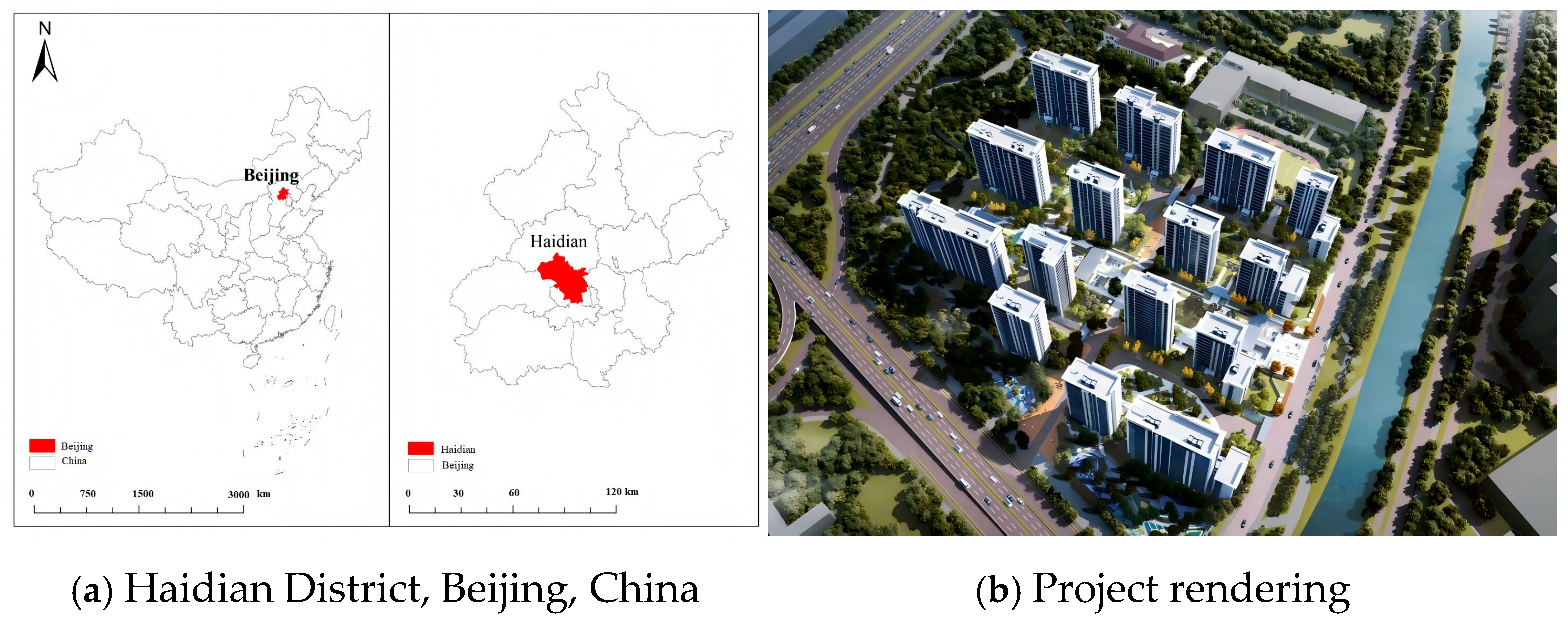
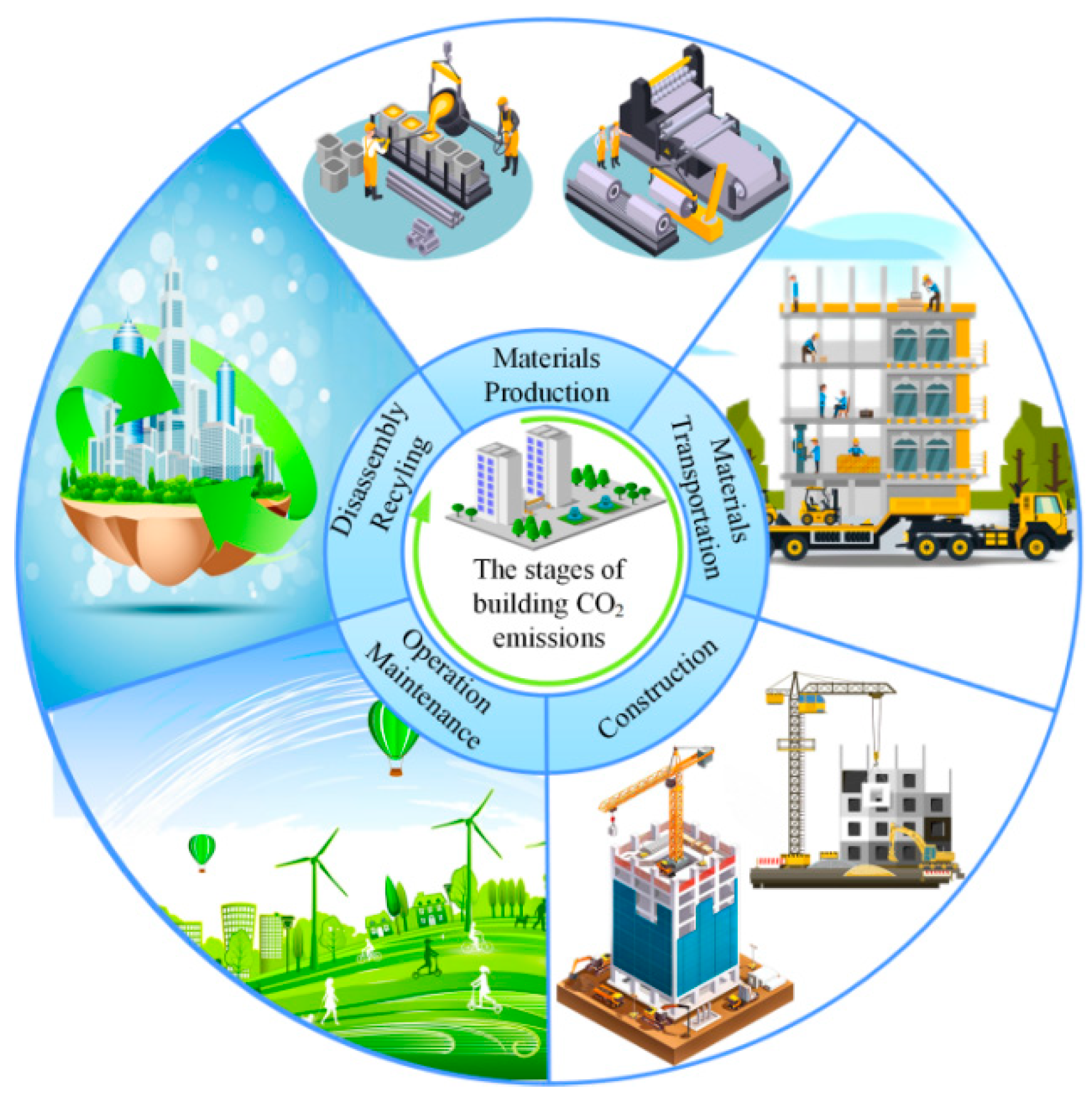
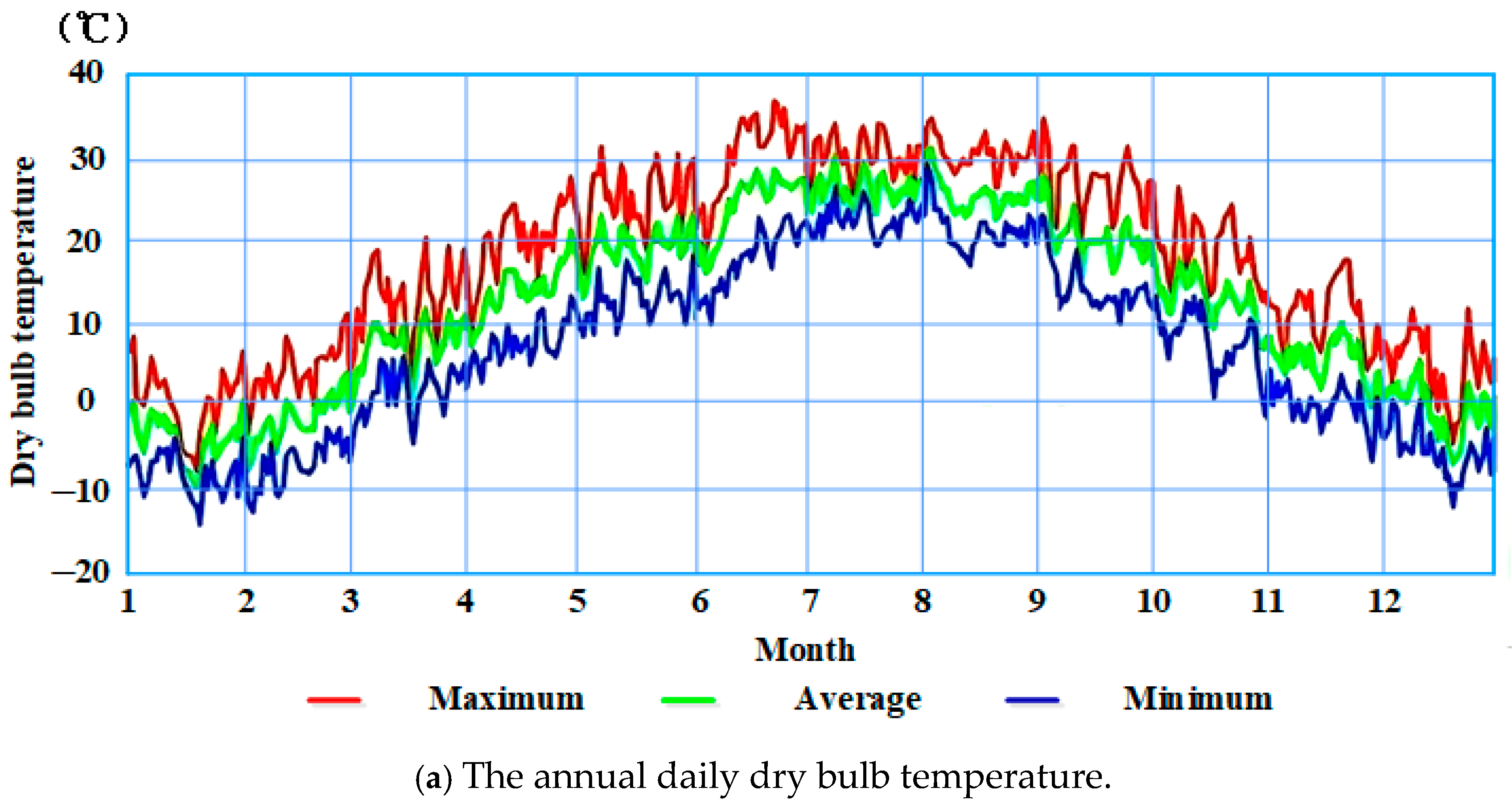
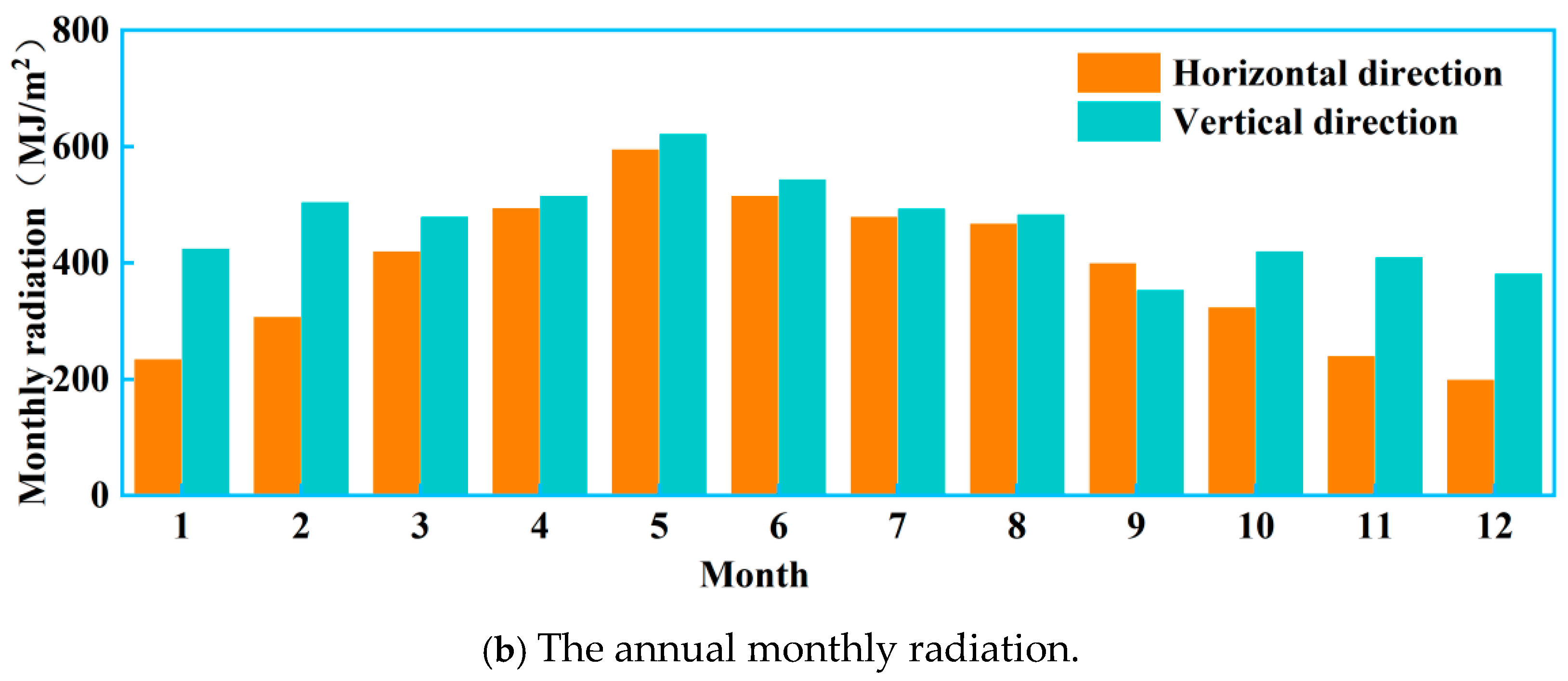
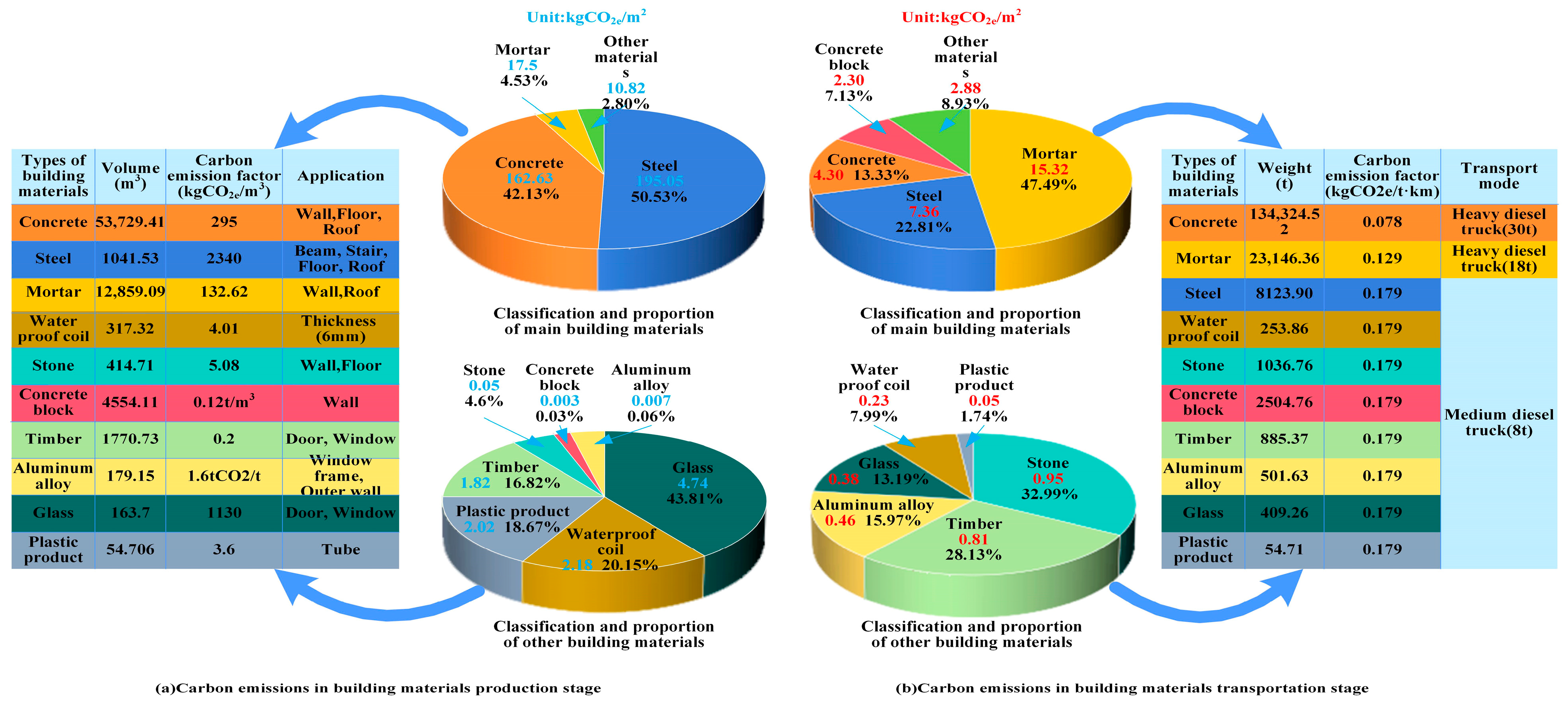

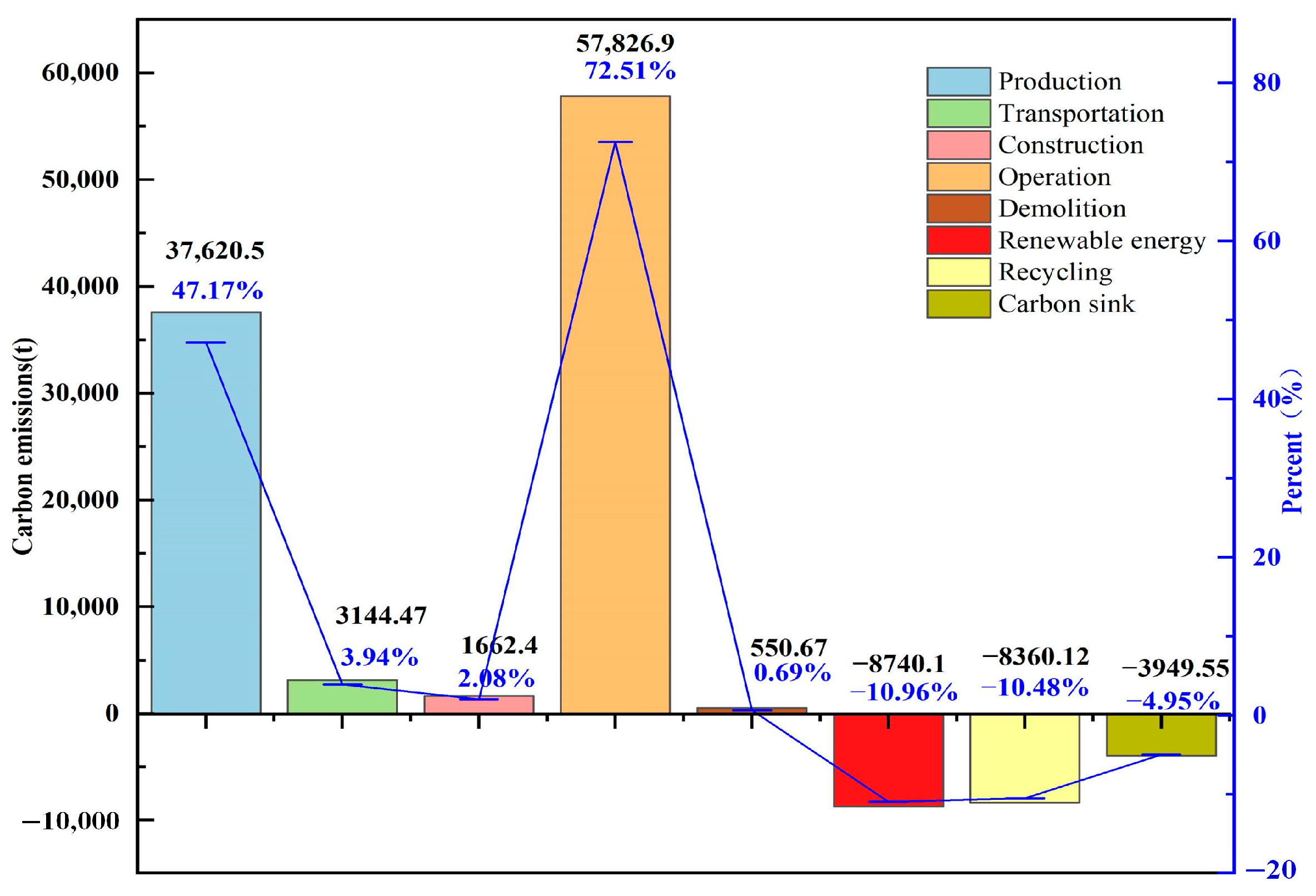
| Name of Construction Machinery | Energy Consumption per Unit Machine-Team | Unit of Energy Consumption | Total Machine-Team Consumption of Construction Machinery (Machine-Team) |
|---|---|---|---|
| Spot welder (75 kVA) | 156.63 | kWh/machine-team | 636.11 |
| Electric hammer (520 w) | 4.06 | kWh/machine-team | 10,394.12 |
| Electric single-barrel slow winch (30 kN) | 28.76 | kWh/machine-team | 3622.70 |
| Electric drill | 6.33 | kWh/machine-team | 1223.49 |
| Steel bar cutter (40 mm) | 32.10 | kWh/machine-team | 238.78 |
| Pipe cutter (150 mm) | 12.90 | kWh/machine-team | 93.24 |
| Steel wheel internal combustion roller (8 t) | 19.79 | kg diesel oil/machine-team | 93.24 |
| Electric tamper (250 Nm) | 16.6 | kWh/machine-team | 13,242.64 |
| Mortar mixer (200 L) | 8.61 | kWh/machine-team | 4212.68 |
| Concrete vibrator (plug-in type) | 11.70 | kWh/machine-team | 4295.53 |
| Concrete vibrator (plate type) | 5.86 | kWh/machine-team | 626.04 |
| Motorized dump truck (1 t) | 6.03 | kg diesel oil/machine-team | 3365.08 |
| Ac arc welding machine (32 kVA) | 96.53 | kWh/machine-team | 12,592.56 |
| Multifaceted woodworking cutting machine (400 mm) | 30.70 | kWh/machine-team | 25.67 |
| Wood drilling machine | 4.7 | kWh/machine-team | 21.12 |
| Woodworking mortise machine (160 mm) | 27 | kWh/machine-team | 9.75 |
| Woodworking flat planer (500 mm) | 12.9 | kWh/machine-team | 24.69 |
| Woodworking three side press planer (400 mm) | 52.4 | kWh/machine-team | 43.21 |
| Woodworking circular saw machine (500 mm) | 24 | kWh/machine-team | 75.70 |
| Polishing machine | 82.00 | kWh/machine-team | 20.14 |
| Dynamic tamping machine (1200 kNm) | 32.75 | kg diesel oil/machine-team | 924.28 |
| Watering cart (4000 L) | 30.21 | kg diesel oil/machine-team | 804.40 |
| Rock cutter (3 kW) | 11.28 | kWh/machine-team | 99.74 |
| Concrete mixer (500 L) | 55.04 | kWh/machine-team | 2629.23 |
| Crawler bulldozer (105 kw) | 60.80 | kg diesel oil/machine-team | 76.02 |
| truck (6 t) | 33.24 | kg diesel oil/machine-team | 52.95 |
| truck (8 t) | 35.49 | kg diesel oil/machine-team | 29.89 |
| Truck crane (8 t) | 28.43 | kg diesel oil/machine-team | 19.82 |
| Crawler crane (15 t) | 29.52 | kg diesel oil/machine-team | 13.97 |
| Truck crane (20 t) | 38.41 | kg diesel oil/machine-team | 16.57 |
| Wheeled tractor (21 kW) | 18.10 | kg diesel oil/machine-team | 10.40 |
| Caterpillar diesel pile driver (2.5 t) | 44.37 | kg diesel oil/machine-team | 5814.65 |
| Crawler single bucket hydraulic excavator | 63.00 | kg diesel oil/machine-team | 232.94 |
| Planting Code | Planting Modes | The Amount of Carbon Sequestration (kg/m2) |
|---|---|---|
| P1 | large and small arbors, shrubs, flowers, and plants were mixed (with an average planting spacing of trees < 3.0 m) | 1200 |
| P2 | broadleaf large arbors | 900 |
| P3 | broadleaf small arbors, coniferous arbors, deciduous arbors | 600 |
| P4 | palm | 400 |
| P5 | dense shrubs | 300 |
| P6 | perennial vines | 100 |
| P7 | grass flower bed, weed, lawn, aquatic plant | 20 |
| Name of Construction Machinery | Energy Consumption per unit Machine-Team | Unit of Energy Consumption | Total Machine-Team Consumption of Construction Machinery (Machine-Team) |
|---|---|---|---|
| Spot welder (75 kVA) | 156.63 | kWh/machine-team | 565.61 |
| Electric hammer (520 w) | 4.06 | kWh/machine-team | 9243.08 |
| Electric single-barrel slow winch (30 kN) | 28.76 | kWh/machine-team | 3221.48 |
| Electric drill | 6.33 | kWh/machine-team | 1088.01 |
| Steel bar cutter (40 mm) | 32.10 | kWh/machine-team | 212.14 |
| Pipe cutter (150 mm) | 12.90 | kWh/machine-team | 82.84 |
| Steel wheel internal combustion roller (8 t) | 19.79 | kg diesel oil/machine-team | 82.84 |
| Electric tamper (250 Nm) | 16.6 | kWh/machine-team | 11,776.15 |
| Mortar mixer (200 L) | 8.61 | kWh/machine-team | 3746.16 |
| Concrete vibrator (plug-in type) | 11.70 | kWh/machine-team | 3819.91 |
| Concrete vibrator (plate type) | 5.86 | kWh/machine-team | 556.84 |
| Motorized dump truck (1 t) | 6.03 | kg diesel oil/machine-team | 2992.44 |
| Ac arc welding machine (32 kVA) | 96.53 | kWh/machine-team | 11,197.87 |
| Multifaceted woodworking cutting machine (400 mm) | 30.70 | kWh/machine-team | 22.43 |
| Wood drilling machine | 4.7 | kWh/machine-team | 18.84 |
| Woodworking mortise machine (160 mm) | 27 | kWh/machine-team | 8.77 |
| Woodworking flat planer (500 mm) | 12.9 | kWh/machine-team | 22.09 |
| Woodworking three side press planer (400 mm) | 52.4 | kWh/machine-team | 38.34 |
| Woodworking circular saw machine (500 mm) | 24 | kWh/machine-team | 67.25 |
| Polishing machine | 82.00 | kWh/machine-team | 17.87 |
| Dynamic tamping machine (1200 kNm) | 32.75 | kg diesel oil/machine-team | 821.94 |
| Watering cart (4000 L) | 30.21 | kg diesel oil/machine-team | 715.38 |
| Rock cutter (3 kW) | 11.28 | kWh/machine-team | 88.69 |
| Concrete mixer (500 L) | 55.04 | kWh/machine-team | 2337.82 |
| Crawler bulldozer (105 kw) | 60.80 | kg diesel oil/machine-team | 67.57 |
| truck (6 t) | 33.24 | kg diesel oil/machine-team | 47.11 |
| truck (8 t) | 35.49 | kg diesel oil/machine-team | 26.64 |
| Truck crane (8 t) | 28.43 | kg diesel oil/machine-team | 17.54 |
| Crawler crane (15 t) | 29.52 | kg diesel oil/machine-team | 12.67 |
| Truck crane (20 t) | 38.41 | kg diesel oil/machine-team | 14.62 |
| Wheeled tractor (21 kW) | 18.10 | kg diesel oil/machine-team | 9.10 |
| Caterpillar diesel pile driver (2.5 t) | 44.37 | kg diesel oil/machine-team | 5170.74 |
| Crawler single bucket hydraulic excavator | 63.00 | kg diesel oil/machine-team | 206.95 |
| Building Area (m2) | Diesel Consumption (kg) | Diesel Factor (t/kg) | Power Consumption (kWh) | Power Factor (t/kWh) | CO2 Emissions (t) |
|---|---|---|---|---|---|
| 97,463.14 | 358,596.46 | 0.003095 | 1,619,961.49 | 0.000341 | 1662.40 |
| Types of Energy Consumption | Annual Consumption (kWh/m2·a) | Annual Energy Consumption of Coal (kg/m2·a) | Annual CO2 Emissions (t/a) |
|---|---|---|---|
| Renewable energy generation | 4.89 | −0.6 | −174.802 |
| Building Area (m2) | Diesel Consumption (kg) | Diesel Factor (t/kg) | Power Consumption (kWh) | Power Factor (t/kWh) | CO2 Emissions (t) |
|---|---|---|---|---|---|
| 97,463.14 | 148,096.54 | 0.003095 | 270,445.27 | 0.000341 | 550.67 |
| Types of Recycled Building Materials | Weight (t) | Recycling Rate | Carbon Emission Coefficient | CO2 Emissions (t) |
|---|---|---|---|---|
| Steel | 8123.895 | 0.4 | −2.53 | −8221.382 |
| Glass | 409.256 | 0.3 | −1.13 | −138.738 |
| Total | −8360.120 | |||
| Parameters | Variation Range | Annual CO2 Emissions per Unit Area (kg/m2·a) | Compared with Existing Design |
|---|---|---|---|
| Existing design | - | 16.366 | - |
| Concrete | +10% | 16.700 | +2.04% |
| Steel | +10% | 16.787 | +2.57% |
| Heating | +10% | 16.704 | +2.07% |
| Electricity | +10% | 17.219 | +5.21% |
| Reference | Country | CO2 Emissions | ||||||
|---|---|---|---|---|---|---|---|---|
| Production Stage | Transportation Stage | Construction Stage | Operational Stage | Demolition Stage | Recycling Stage | Total (t) | ||
| This paper | China | 47.17% | 3.94% | 2.08% | 61.54% (including renewable energy) | 0.69% | −10.48% | 79,755 |
| [9] | China | 12.6% | 85.4% | 2% | - | 85,667 | ||
| [27] | China | 7.8% | <1% | >90% | - | - | - | |
| [28] | Australia | 11% | 2% | 87% | - | - | 14,229 | |
| [29] | USA and Europe | 10%/12% | 90%/88% | - | - | - | ||
| [30] | Brazil | 30% | 56% | 14% | - | 282.62 | ||
Disclaimer/Publisher’s Note: The statements, opinions and data contained in all publications are solely those of the individual author(s) and contributor(s) and not of MDPI and/or the editor(s). MDPI and/or the editor(s) disclaim responsibility for any injury to people or property resulting from any ideas, methods, instructions or products referred to in the content. |
© 2025 by the authors. Licensee MDPI, Basel, Switzerland. This article is an open access article distributed under the terms and conditions of the Creative Commons Attribution (CC BY) license (https://creativecommons.org/licenses/by/4.0/).
Share and Cite
Li, L.; Gao, L.; Zhang, X.; Xu, H.; Jiang, L. Research on Building’s Carbon Emission Calculation and Reduction Strategy Based on Life Cycle Assessment (LCA) and Building in Formation Modeling (BIM): A Case Study in Beijing, China. Buildings 2025, 15, 1403. https://doi.org/10.3390/buildings15091403
Li L, Gao L, Zhang X, Xu H, Jiang L. Research on Building’s Carbon Emission Calculation and Reduction Strategy Based on Life Cycle Assessment (LCA) and Building in Formation Modeling (BIM): A Case Study in Beijing, China. Buildings. 2025; 15(9):1403. https://doi.org/10.3390/buildings15091403
Chicago/Turabian StyleLi, Li, Lijun Gao, Xin Zhang, Huijuan Xu, and Lu Jiang. 2025. "Research on Building’s Carbon Emission Calculation and Reduction Strategy Based on Life Cycle Assessment (LCA) and Building in Formation Modeling (BIM): A Case Study in Beijing, China" Buildings 15, no. 9: 1403. https://doi.org/10.3390/buildings15091403
APA StyleLi, L., Gao, L., Zhang, X., Xu, H., & Jiang, L. (2025). Research on Building’s Carbon Emission Calculation and Reduction Strategy Based on Life Cycle Assessment (LCA) and Building in Formation Modeling (BIM): A Case Study in Beijing, China. Buildings, 15(9), 1403. https://doi.org/10.3390/buildings15091403





